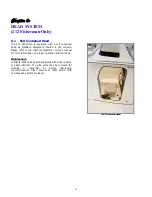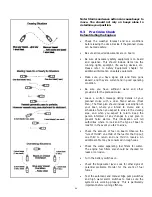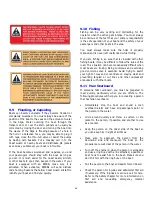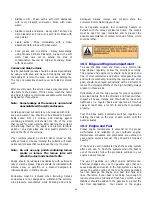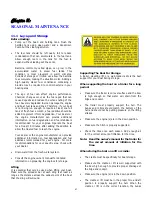
boats, obstacles and navigational markers until you
reach port or conditions improve.
• Your Wellcraft is a heavy boat that will produce a
large wake at certain speeds. You are responsible
for damage and injury caused by your boat's wake.
Always observe no wake zones and be aware that
your wake can endanger small vessels and their
passengers. Always be courteous and slow down to
reduce your wake when passing smaller boats.
• Before operating the boat for the first time, read the
engine break-in procedures. The break-in
procedures are found in the owner’s manual for the
engines. The manual is in the literature packet.
• As different types of engines are used to power the
boat, have the dealer describe the operating
procedures for your boat. For more instructions on
“How To Operate The Boat,” make sure you read
the instructions given to you in the owner’s manual
for the engines you have selected.
Note:
For more instructions on safety,
equipment and boat handling, enroll in
one of the several free boating courses
offered. For information on the courses
offered in your area, call the “Boating
Course Hotline,” 1-800-368-5647 or on
the WEB at www.uscgboating.org.
Note: If the running gear hits an underwater
object, stop the engines. Inspect the
propulsion system for damage. If the
system is damaged, contact your dealer
for a complete inspection and repair of the
unit.
To stop the boat, follow this procedure:
• Allow the engines to drop to the idle speed.
• Make sure the shifting levers are in the neutral
position.
Note: If the engines have been run at high speed
for a long period of time, allow the
engines to cool down by running the
engines in the idle position for 3 to 5
minutes.
• Turn the ignition keys to the “OFF” position.
• Raise the trim tabs to the full up position.
After Operation:
• If operating in saltwater, wash the boat and all
equipment with soap and water.
• Check the bilge area for debris and excess water.
• Fill the fuel tank to near full to reduce condensation.
Allow enough room in the tank for the fuel to
expand without being forced out through the vent.
•
Turn off all electrical equipment except the
automatic bilge pumps.
• If you are going to leave the boat for a long period
of time, put the battery main switches in the “OFF”
position and close all seacocks.
• Make sure the boat is securely moored.
9.5 Docking, Anchoring and
Mooring
Docking and Dock Lines
Maneuvering the boat near the dock and securing the
boat require skill and techniques that are unique to the
water and wind conditions and the layout of the dock. If
possible, position a crew member at the bow and stern
to man the lines and assist in docking operations. While
maneuvering close to the dock consideration must be
giving to the wind and current. You should anticipate the
effect these forces will have on the boat and use them
to help put the boat where you want it. It is important to
practice in open water using an imaginary dock enough
to develop a sense for the way your boat handles in a
variety of docking scenarios. You must be able to
foresee the possibilities and have solutions in mind
before problems occur.
Approaching a dock or backing into a slip in high winds
or strong currents requires a considerable amount of
skill. If you are new to boat handling, you should take
lessons from an experienced pilot to learn how to
maneuver your boat in tight quarters in less than ideal
conditions. You should also practice away from the dock
during windy conditions. Dock lines are generally twisted
or braided nylon. Nylon is strong and stretches to absorb
shock. It also has a long life and is soft and easy on the
hands. The line's size will vary with the size of the boat.
Typically a 30 to 40 foot boat will use 5/8-inch line and a
20 to 30 foot boat will use 1/2-inch line. The number of
lines and their configuration will vary depending on the
46
Summary of Contents for 180 Sportsman
Page 2: ...2...
Page 4: ...4...
Page 7: ...180 FISHERMAN SPECIFICATIONS 7...
Page 8: ...180 SPORTSMAN SPECIFICATIONS 8...
Page 9: ...202 FISHERMAN SPECIFICATIONS 9...
Page 10: ...212 FISHERMAN SPECIFICATIONS 10...
Page 18: ...18...
Page 39: ...SAFETY LABELS 2601 1124 39...
Page 40: ...180 FISHERMAN 180 SPORTSMAN CAPACITY LABELS 40...
Page 41: ...202 212 FISHERMAN CAPACITY LABELS 41...
Page 61: ...Appendix A SCHEMATICS 180 FISHERMAN INSTRUMENT PANEL 61...
Page 62: ...Appendix A SCHEMATICS 180 SPORTSMAN INSTRUMENT PANEL 62...
Page 63: ...Appendix A SCHEMATICS 202 212 FISHERMAN INSTRUMENT PANEL 63...
Page 68: ...Appendix A SCHEMATICS 180 FISHERMAN 180 SPORTSMAN TRAILER DRAWING 68...
Page 69: ...Appendix A SCHEMATICS 202 212 FISHERMAN TRAILER DRAWING 69...
Page 70: ...Appendix A SCHEMATICS 180 FISHERMAN OVERHEAD LAYOUT 70...
Page 71: ...Appendix A SCHEMATICS 180 SPORTSMAN OVERHEAD LAYOUT 71...
Page 72: ...Appendix A SCHEMATICS 202 FISHERMAN OVERHEAD LAYOUT 72...
Page 73: ...Appendix A SCHEMATICS 212 FISHERMAN OVERHEAD LAYOUT 73...
Page 77: ...MAINTENANCE LOG 77...
Page 78: ...MAINTENANCE LOG 78...
Page 80: ...Appendix D BOAT ACCIDENT REPORT 80...
Page 81: ...81...
Page 87: ...Appendix F TROUBLESHOOTING GUIDE 87...
Page 88: ...TROUBLESHOOTING GUIDE 88...
Page 89: ...TROUBLESHOOTING GUIDE 89...
Page 90: ...TROUBLESHOOTING GUIDE 90...
Page 91: ...TROUBLESHOOTING GUIDE 91...



